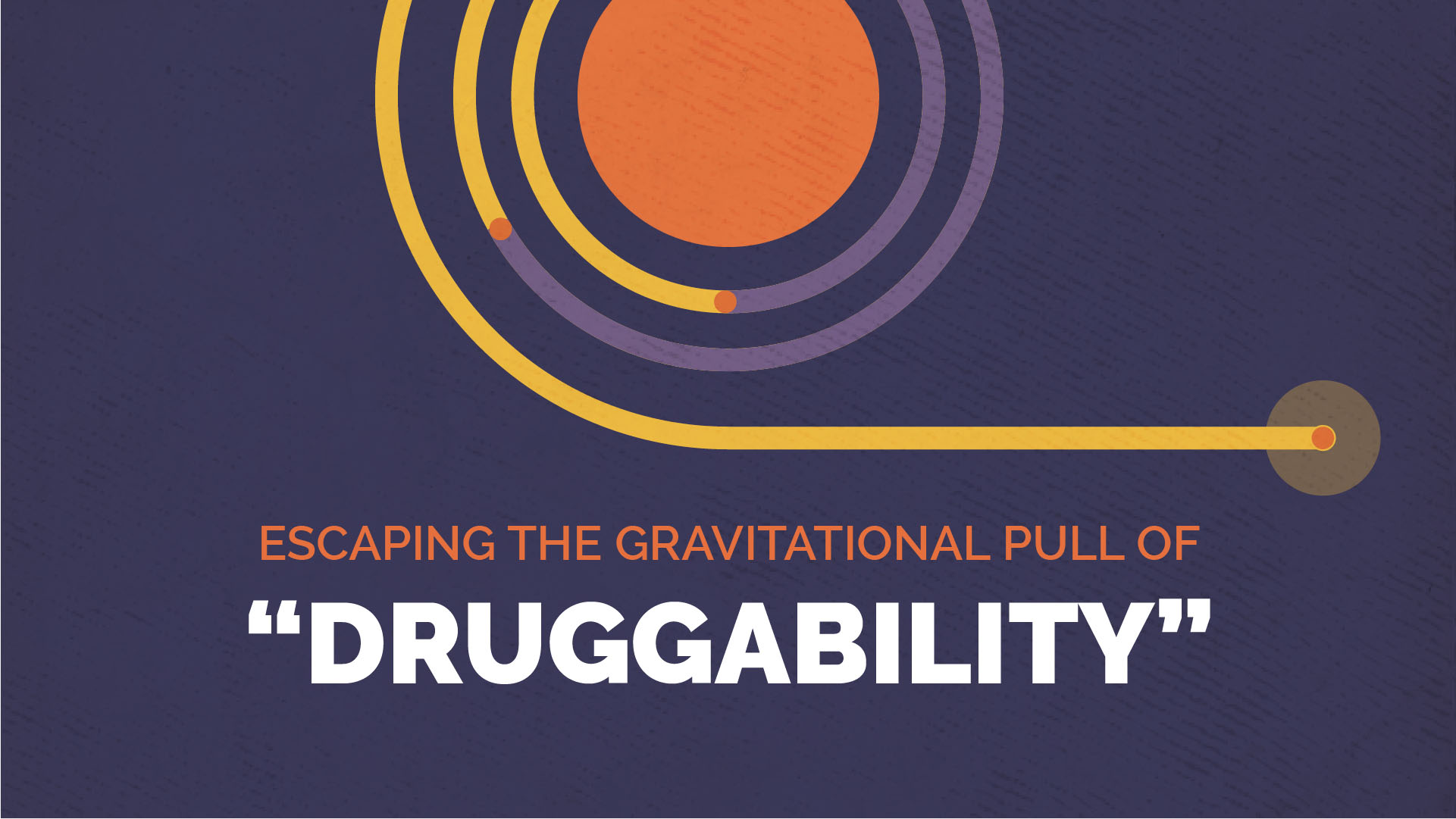Escaping the Gravitational Pull of “Druggability”
Michael Gilman, PhD, CEO, Arrakis


Most old-timers in drug discovery will agree on one thing: It never gets easier. Sure, maybe we learn a little from our mistakes along the way and the toolkit gets steadily flashier. But the easy targets, if ever they were truly easy ones, are long gone. We are left with either inscrutable biology or, even more frustrating, compelling biology performed by molecules that are out of our reach—“undruggable” is the self-fulfilling neologism we use.
Consider, for a moment, Ras and Myc, the two Ur-oncogenes whose open-and-shut culpability in human cancer has been known for thirty years. How the hell do we drug those things?
What about transcription factors—Stats, Smads, and the rest? We know they do much of the heavy lifting in biology and clearly go haywire in disease. But these molecules have largely resisted our attempts to intervene therapeutically.
Then there are the smoking-gun proteins—molecules with unassailable genetic links to disease but whose structure and function remain largely mysterious to us—think Huntingtin, α-synuclein, β-amyloid—and consequently, we have no idea how to target them effectively.
Don’t even get me started on RNA. When I was a graduate student, there were three kinds of RNA—m, r, and t. We pretty much knew what they did. Today you need a minor in zoology to keep track of all the different types of RNA transcribed from what we used to call junk DNA. This is the dark matter of biology—massive, mysterious, and very difficult to get our hands on.
Stuck in earth’s orbit
The universe of biology is vast. Yet precious little of it is available to modern medicinal chemistry, the miraculous discipline that has given us hundreds of effective, well-behaved, orally active pills, tablets, and capsules. Whether through inherent limits or limits of our imagination, modern medicinal chemistry has little purchase on the vast majority of molecules that execute the biology in our cells.
Today’s small-molecule pharmacopeia is limited to roughly 500 targets, almost entirely proteins of a small number of structural classes, typically enzymes or receptors with well-defined pockets friendly to Lipinski-compliant drug compounds. If you expand to all members of these classes, you get to perhaps 3,000 accessible targets. But this is the drug-discovery equivalent of looking for your keys under the lamppost. Just because we can drug them, doesn’t mean that they’re worth our time.
Here’s a question that’s been on my mind lately. Is medicinal chemistry truly limited to this small slice of the proteome, or are we being held back by our own orthodoxy?
Set your controls for the heart of the genome
How do we escape earth’s orbit to access the full universe of biology? What about, for example, the “undruggable” proteome, perhaps 20,000 additional proteins encoded by the human genome? But now we’re facing the Myc’s and Ras’s of the universe, the transcription factors, adaptors, scaffolds and structural proteins, with their slippery, flat surfaces that offer no handhold.
Beyond the protein world looms the galaxy of non-coding RNA, perhaps a log-order larger than the set of RNAs that encode proteins.
How do we bring this broader universe of biology to bear on the many illnesses we still treat poorly or not at all?
In general, getting beyond the biology represented by the so-called “druggable” proteins has required invention of orthogonal therapeutic modalities, notably antibodies, oligonucleotide drugs, and gene and cell therapies. Antibodies, clearly, make very effective drugs, largely because they are natural molecules precision-tuned by evolution to circulate and surveil in the body – as long as their target is outside the cell. As for oligonucleotides and gene/cell therapies, we’re seeing—at last—a glimmer of great promise; but these therapies are still not quotidian for drug developers, physicians, or patients. And I think it’s fair to say that we still don’t understand their full potential for chronic use in large populations.
We do know small molecules, though. We know how to discover them and how to improve them. We know how to manufacture, formulate, and deliver them to your local pharmacy. We know what kinds of toxicities they can generate and how to test for unanticipated ones. We understand their pharmacokinetics, their metabolism, and their biodistribution. Sure, we get surprised occasionally. But we’ve been taking pills for decades—I know I have—and we know what they can do. It’s the devil we know.
So how do we leverage this devil we know into all the compelling biology that is currently off-limits to small molecules? Can we break free of the constraints of Lipinski’s Rule of Five to find small molecules that do new things? Or are those compounds already lurking in our libraries while nothing but our own dogma prevents us from looking for them?
It’s an RNA world
Here’s one way to break loose. How about skipping protein targets entirely and going straight for their encoding RNAs?
This is not entirely crazy. Many approved antibiotics act by binding to ribosomal RNA. And Novartis’s fascinating splice-corrector LMI070, which is in clinical trials for spinal muscular atrophy, appears to act by binding specifically to the errant splice site in SMN2 pre-mRNA and stabilizing its interaction with the U1 snRNP. LMI070 is a pleasingly conventional small molecule that a non-chemist like me would not be blamed for confusing with a kinase inhibitor. Importantly, it is orally bioavailable and penetrates the blood-brain barrier. It’s proven safe enough to enter clinical development, suggesting it’s unlikely to be a pleiotropic RNA binder. Consider, too, ribocil, a very ordinary-looking molecule that Merck identified in a phenotypic screen in E. coli. It turns out to act by binding to a riboswitch, a ligand-regulated RNA structure found in the 5’-untranslated regions of certain bacterial mRNAs.
What unifies these cases is that these compounds were identified in functional screens. Only later did investigators figure out that they acted by binding to RNA. Who knows, maybe there are other RNA binders in our medicine cabinet and thousands more in our compound libraries. We just need to look.
There’s no reason small molecules shouldn’t bind to RNA with the same facility as proteins. RNA molecules have a similar complement of functional groups—plenty of hydrogen-bond donors and acceptors, for example. And RNA has structure. We tend to focus mostly on secondary structure—i.e., base pairing—but most of the structural diversity in RNA derives from tertiary structure, owing to multiple degrees of rotational freedom in the phosphodiester bonds.
What about mRNA? The textbook conception of mRNA is that it’s a floppy molecule—in fact its principal job is to linearize itself for translation. Nevertheless, it is almost certain that all RNAs in the cell are folded, so perhaps it’s possible to capture these structures with a small molecule and impact function.
Interest in targeting RNA with small molecules intentionally rather than by accident is heating up. See, for example, this recent paper from Matt Disney at Scripps, who is one of the leaders in the field. And word on the street is that there are skunk works afoot in many pharma labs around the world.
So maybe drugging RNA is a key to unlocking all that undruggable biology. Therapeutic targeting of RNA can open up a universe of possibilities—blocking splicing of pre-mRNA, translation of mature mRNA by the ribosome, stability of mRNA to degradation, the processing of miRNA, the function of lncRNA and other newly-discovered regulatory RNAs. Can we slip the surly bonds of earth, reject our dogma about what small molecules can and cannot do, and point our powerful drug discovery toolkit at RNA instead of proteins to access a new universe of biology?
Stay tuned.
